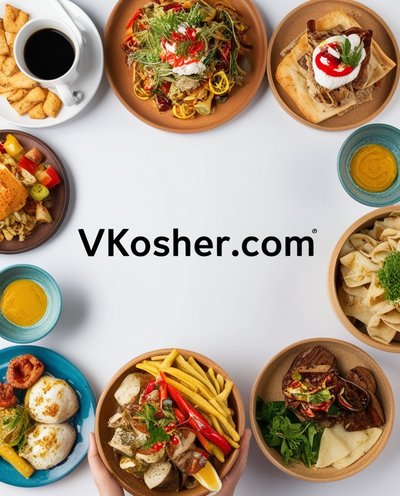Understanding Kosher Meals: A Comprehensive Guide
Kosher meals are an integral part of Jewish dietary laws, rooted in ancient religious traditions and still observed by many today. The term "kosher" itself comes from the Hebrew word "kasher," meaning fit or proper, and refers to foods that comply with a complex set of dietary laws as outlined in the Torah. These laws, known as kashrut, dictate what foods are permissible and how they should be prepared, consumed, and handled.
The Foundations of Kashrut
The foundation of a kosher meal lies in the observance of kashrut. Kashrut is not just a set of dietary restrictions but a spiritual practice that involves mindful eating. The laws are derived from the Torah, particularly the books of Leviticus and Deuteronomy, where the rules for permissible and forbidden foods are spelled out in detail. For example, the Torah specifies that land animals must have cloven hooves and chew their cud to be considered kosher, such as cows, sheep, and goats. Pigs, on the other hand, are forbidden because they do not meet both criteria.
Fish must have fins and scales to be kosher, which excludes shellfish like shrimp, lobster, and clams. Birds considered kosher are typically domestic fowl such as chickens, ducks, and turkeys, while birds of prey are not allowed. In addition to these classifications, the Torah prohibits consuming blood, which has led to specific slaughtering techniques that ensure blood is drained from meat and poultry.
The Role of Shechita in Kosher Meat
One of the critical aspects of kosher meat is the process of shechita, the ritual slaughter carried out by a trained individual known as a shochet. This process is designed to minimize the animal's pain and is carried out with a swift, precise cut across the throat using a sharp knife called a chalaf. The cut is meant to sever the main arteries and windpipe, resulting in quick and humane death. After the animal is slaughtered, the meat is inspected for any signs of disease or imperfection. If the animal is found to be healthy, the meat can be certified as kosher.
Following slaughter, the meat undergoes a process called kashering, where it is soaked and salted to remove any remaining blood. This step is crucial because consuming blood is strictly prohibited in the kosher diet. The meat is then rinsed thoroughly to remove excess salt, making it ready for consumption. The entire process is closely monitored by a mashgiach, a kosher supervisor, who ensures that all aspects of kashrut are observed.
Separation of Meat and Dairy
One of the most well-known aspects of a kosher diet is the separation of meat and dairy products. This practice is based on a verse in the Torah that forbids boiling a young goat in its mother's milk. Jewish sages have interpreted this commandment to mean that meat and dairy must not be eaten together, nor should they be cooked or stored together. This separation extends to the utensils and dishes used for meat and dairy, which must be kept separate to avoid any cross-contamination.
In a kosher kitchen, it's common to have two sets of cookware, dishes, and utensils—one for meat and one for dairy. There is also a waiting period between consuming meat and dairy, which varies among Jewish communities but generally ranges from one to six hours. The exact length of time depends on tradition and custom, reflecting the importance of maintaining a clear distinction between these two food categories.
The Importance of Kosher Certification
In today's globalized food market, kosher certification has become an essential tool for those who observe kashrut. Kosher certification is a process by which a product is inspected and verified as meeting the standards of kashrut. This certification is carried out by reputable agencies or individual rabbis who are experts in Jewish dietary laws. Once a product is certified, it carries a kosher symbol, often referred to as a hechsher, which appears on the packaging.
There are various kosher certification symbols, each representing a different certifying organization. Some of the most recognized symbols include OU (Orthodox Union), Kof-K, Star-K, and OK. These symbols provide consumers with the assurance that the product they are purchasing adheres to kosher standards. This certification process is particularly important for processed foods, as many additives, preservatives, and flavorings may contain non-kosher ingredients.
Kosher Wine and Grape Products
Grape products hold a unique place in kosher dietary laws. For wine to be considered kosher, it must be produced under strict supervision from the time the grapes are harvested until the wine is bottled. This supervision is necessary because wine has historically been used in religious rituals, both within and outside of Judaism, leading to stringent regulations.
For wine to be kosher, it must be made by Sabbath-observant Jews, and all ingredients and equipment used in the winemaking process must be kosher. Additionally, any wine used for sacramental purposes must be mevushal, meaning it has been heated to a specific temperature to render it suitable for consumption by all, including those who may not strictly observe the Sabbath.
Other grape products, such as grape juice and jelly, are also subject to kosher regulations. Like wine, these products must be produced under supervision to ensure that no non-kosher substances have been introduced during processing.
The Kosher Kitchen: Maintaining Kashrut at Home
Maintaining a kosher kitchen requires careful attention to detail and adherence to the principles of kashrut. For those new to the practice, setting up a kosher kitchen can be a significant undertaking, but it is an essential part of living a kosher lifestyle. The primary challenge is ensuring the separation of meat and dairy, which involves having separate cooking and eating utensils, as well as distinct storage spaces for each.
In a kosher kitchen, it's common to have color-coded utensils and cutting boards to prevent accidental mixing of meat and dairy. Appliances like ovens and microwaves may also need to be designated for either meat or dairy, or in some cases, kashered—a process of making them kosher—if they have been used for both.
The observance of Passover, a significant Jewish holiday, adds another layer of complexity to kosher kitchen practices. During Passover, additional restrictions are placed on the consumption of leavened bread and other foods containing chametz (leavening agents). As a result, many kosher homes undergo a thorough cleaning before Passover to remove all traces of chametz, and special Passover-specific utensils and cookware are used.
The Diversity of Kosher Cuisine
Kosher cuisine is as diverse as the Jewish people themselves, reflecting the wide range of cultural influences that have shaped Jewish culinary traditions over centuries. From the Ashkenazi traditions of Eastern Europe to the Sephardic flavors of the Mediterranean and Middle East, kosher meals can be found in many forms, each with its unique twist on the principles of kashrut.
Ashkenazi kosher cuisine often includes dishes like brisket, gefilte fish, matzo ball soup, and kugel—a type of baked pudding. These foods are rooted in the culinary traditions of Eastern European Jews and are commonly served during Jewish holidays and Shabbat meals.
Sephardic kosher cuisine, on the other hand, draws from the rich culinary heritage of Jews who lived in Spain, North Africa, and the Middle East. Dishes such as couscous, tagine, shakshuka, and borekas showcase the vibrant flavors of these regions while adhering to kosher dietary laws.
In recent years, there has been a resurgence of interest in kosher cuisine, with many chefs and home cooks experimenting with new recipes that blend traditional kosher ingredients with contemporary culinary techniques. This evolution has led to a broader range of kosher products available in the market, making it easier than ever to enjoy kosher meals that are both delicious and diverse.
Kosher Meals in Modern Life
In the modern world, the observance of kosher dietary laws has adapted to the realities of contemporary life. While the principles of kashrut remain unchanged, the availability of kosher foods and the convenience of kosher certification have made it easier for people to maintain a kosher diet no matter where they live.
Kosher meals are now readily available in many grocery stores, restaurants, and even online. This accessibility has expanded the reach of kosher food beyond the Jewish community, with many non-Jews also choosing kosher products for reasons related to health, quality, or ethical considerations.
In institutional settings, such as hospitals, schools, and prisons, providing kosher meals has become a standard practice to accommodate the dietary needs of Jewish individuals. Many airlines also offer kosher meal options for passengers, ensuring that those who observe kashrut can travel without compromising their dietary practices.
The Spiritual Dimension of Kosher Meals
Beyond the physical aspects of food preparation and consumption, kosher meals carry a deep spiritual significance for those who observe kashrut. Eating kosher is seen as an act of obedience to divine commandments, a way of sanctifying everyday life, and a means of maintaining a connection to Jewish heritage and identity.
For many, the act of preparing and consuming kosher food is a reminder of the importance of mindfulness and intentionality in all aspects of life. By following the dietary laws, individuals can cultivate a sense of discipline and reverence for the sacredness of food, recognizing it as a gift from God.
Moreover, the communal aspect of kosher meals, especially during Jewish holidays and Shabbat, strengthens the bonds within families and communities. Sharing a kosher meal is not just about eating together; it is about participating in a tradition that has been passed down through generations, reinforcing the continuity of Jewish life and culture.
The Future of Kosher Cuisine
As the global food landscape continues to evolve, the future of kosher cuisine looks promising. The demand for kosher products is expected to grow, driven by both religious observance and the broader appeal of kosher certification as a mark of quality and safety. Advances in food technology and innovation are likely to introduce new kosher products and cooking techniques, expanding the possibilities for kosher cuisine.
At the same time, the core principles of kashrut will remain




